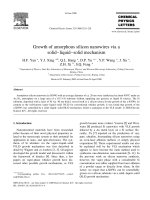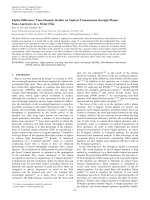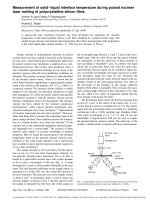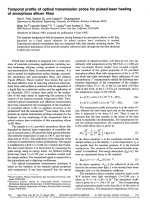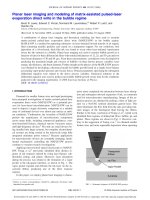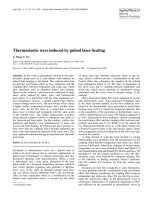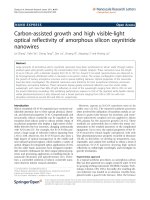temporal profile of optical transmission probe for pulsed laser heating of amorphous silicon films
Bạn đang xem bản rút gọn của tài liệu. Xem và tải ngay bản đầy đủ của tài liệu tại đây (360.18 KB, 3 trang )
Temporal profile of optical transmission probe for pulsed-laser heating
of amorphous silicon films
Hee K. Park, Xianfan Xu, and Costas P. Grigoropoulos
Department
of
Mechanical Engineering, University
of
California, Berkeley, California 94720
Nhan Do a) Leander Klees
b, P. T. Leung,c)
and Andrew C. Tam
IBM Resebch Division, .4lmadLn Research Center, San Jose, California 95120-6099
(Received 26 March 1992; accepted for publication 4 June 1992)
The transient temperature field development during heating of an amorphous silicon (a-Si) film,
deposited on a fused quartz substrate by pulsed excimer laser irradiation is studied.
Experimental optical transmission data are compared with heat transfer modeling results. The
temperature-dependence of the material complex refractive index through the thin film thickness
is taken into account.
Pulsed laser irradiation is employed over a wide spec-
trum of materials processing applications, including sur-
face hardening, alloying, curing, synthesis of compound
and semiconductor films. In semiconductor systems,* it is
used to anneal ion-implantation surface damage, recrystal-
lize amorphous and polycrystalline films, and enhance
dopant diffusion. Recent studies2 have shown that one of
the most effective ways of removing submicron-sized par-
ticles from solid surfaces is achieved with the deposition of
a liquid film on a substrate surface and the application of
an ultraviolet (UV) excimer laser pulse on the surface.
One of the main issues in improving this process is the
control of the induced transient temperature field. Time-
resolved optical transmission and reflection measurements
have been reported for the investigation of the irradiation
of crystalline silicon (c-Si) on sapphire structures at the
picosecond3 and the nanosecond,415 time scales. This work
presents an optical transmission probing technique for the
transient,
in situ
monitoring of the temperature field in
pulsed excimer laser irradiation of thin amorphous silicon
(a-Si) films.
The sample is a 0.2 pm-thick amorphous silicon film
deposited by electron beam evaporation of crystalline sili-
con in vacuum onto a 250 pm-thick fused quartz substrate.
The substrate temperature is kept at 140 “C and the depo-
sition rate at 10 A/s. The uniformity of the thickness of the
a-Si layer is monitored by surface profilometry. The sample
is irradiated by a KrF (il=O.248 ,um) excimer laser beam.
The laser beam fluence
F
is determined by measuring the
pulse energy using an energy meter. An infrared probing
diode laser beam (/2=0.752 ,um) is incident normal onto
the sample surface. The transmitted signal is captured by a
fast photodiode and a digitizing oscilloscope.
The optical transmission measurement technique is
based on the variation of the material optical properties
with temperature. It has been reported’ that the optical
‘IPresent address: Phvsics Department, San Jose State University, Cali-
fornia 95192-0106.
b)Permanent address: Institut fur Angewandte Physik, Technische
Hochschule Darmstadt, Hochschulstr. 6, D-6100 Darmstadt, Germany.
‘IPermanent address: Department of Physics, Portland State University,
Oregon 97207-075 1.
properties of submicron-thick, a-Si films do not vary sig-
nificantly with temperature at the Nd:YAG, il= 1.064
pm
laser wavelength. Recent studies7 have revealed a signifi-
cant variation of the optical properties of 0.2 pm-thick
amorphous silicon films with temperature at the /2=0.752
pm diode laser light wavelength. Static reflectance 9 and
transmittance y measurements yielded the following tem-
perature dependence of the components of the complex
refractive index,
n^=n-ik,
of the 0.2 pm-thick a-Si films
used in this work, at the /Z=0.752~pm wavelength, and in
the temperature range of 293-650 K:
n=n(T)=4.0+1.3~10-4(T-293),
(14
k=k(T)=0.055+2.3x
10-4(T-293).
(lb)
The temperature profile penetration is of the order of 1
pm, whereas the-laser beam spot area on the sample sur-
face is measured to be about 0.5 cm2. Thus, it may be
assumed that the heat transfer at the center of the laser
beam is essentially one-dimensional. For temperatures be-
low the melting temperature, the conductive heat transfer
in the solid silicon layer is given by
(2)
In the above equation, x is the coordinate normal to the
sample surface, p is the density, T is the temperature, Cp is
the specific heat for constant pressure, k’ is the thermal
conductivity. The variation of the material thermal prop-
erties* is considered. The energy absorption, Q&(&t), fol-
lows an exponential decay in the material:
Qab(x,t) = ( l-d?exc)~(t)ae-M.
(3)
In the above equation, gexc
is the reflectivity of the a-Si
layer for the excimer laser light, I is the incident laser beam
intensity, and a is the absorption coefficient.
The amorphous silicon complex refractive index at the
KrF excimer laser light wavelength (;1=0.248 ym) is
taken as
n^=n-ik=
1.69 1’2.76.9 The absorption coeffi-
cient is given by a= 1.398X lo6 cm-t. The corresponding
optical penetration depth in the thin film is of the order of
a few nanometers. The temperature dependence of the ma-
749 Appl. Phys. Lett. 61 (7), 17 August 1992
0003-6951/92/320749-03fiO3.00
@ 1992 American Institute of Physics
749
Downloaded 13 Dec 2007 to 128.46.193.173. Redistribution subject to AIP license or copyright; see />terial optical properties at this wavelength is expected to be
small. It is reasonable to assume that no interference effects
modify the local energy absorption in the thin film, as the
case has shown to be” in pulsed ruby (d=O.694 pm) and
frequency doubled Nd:YAG (/2=0.532 pm) laser irradia-
tion of silicon layers, and in absorption detection of defects
in a-Si:H films.” The reflectivity sy,, is thus considered
constant and can be calculated using the expression for the
normal incidence reflectivity of bulk material surfaces,
~~,,,=[(n-1)2+~]/[(n+1)2+k?]=0.545.
Measure-
ments of the laser pulse temporal profile have shown that
the pulse fluence F is distributed in a triangular shape, with
the pulse length
tl=26
ns, and the peak intensity occurring
at tP=6 ns.
2Ft
1(t) =-)
vp
o<t<tp
I(t) =
2F(tl-t)
tl(+- $1 ’
t* < t < t1.
(4)
I(t) =o,
t[ < f.
Convection and thermal radiation losses are negligible for
the high incident laser pulse intensities used (of the order
of 10” W/m2), and time scales considered in this work.
The temperature penetration in the structure is small, so
that the bottom substrate surface remains at the ambient
temperature
T, .
(54
T(x=dsi+dDt) = T,.
(5b)
where
dsi
and
d,q
are the thicknesses of the a-Si layer and
the substrate correspondingly. Initially the structure is iso-
thermal at the ambient temperature.
T(x,O)
= T,.
(6)
The heat conduction is solved numerically by an im-
plicit finite difference algorithm. The a-Si layer was dis-
cretized into N=20 equal increments. A time step, At=2
X
lo-i2 s was used in the calculations. The
a-Si
layer is
partially transparent for the probing laser light wavelength
(/2=0.752 pm). The temperature field in the semiconduc-
tor film induces changes in the material refractive index
[Eqs. (la) and (lb). Such changes were accounted for in
the picosecond irradiation of thin c-Si films3 by assuming
an average film temperature for the fitting of the measured
optical properties. In this study, the semiconductor film is
treated as a stratified multilayer structure,“-I4 composed
of N layers of varying complex refractive index. The
m
= l, ,N layers within the a-Si tllm are absorbing and have
a temperature dependent complex refractive index, given
by Eqs. ( la) and ( lb). The substrate is represented by the
m=N+
1 layer, and is transparent to the probing laser
light, having a refractive index that is real, n^,+i= 1.46.
Utilizing the formalism of the characteristic transmission
matrix, the lumped structure reflectivity and transmissivity
can be obtained. The mth layer of thickness
d,,
having a
2 600
5
cn
0
30 60 90
Time (ns)
120 150
FIG. 1. Surface temperature histories for a 0.2 pm-thick amorphous
silicon layer, irradiated with an excimer laser (A=O.248 pm) for laser
fluences F= 19.6,31.6,46.6 mJicm’. The laser pulse length ~-26 ns. The
solid lines show calculated data.
complex refractive index Gm=nrn
-ik,,
is represented by
the 2 X 2 matrix L,,, whose elements are complex:
cos( T;;,d,)
&sin(
:$d,)
in),
sin( 2
n^,d,) cos(g &d,n)
’
(7)
The multilayer transmission. matrix ,d is:
N+l
“.d= II dm.
??I=1
(8)
The reflection and transmission Fresnel coefficients, r and
tn are:
(9b)
The structure reflectivity sPrb and transmissivity yprb for
the probing laser in terms of r and t,, follow:
9\prb=lr12,
(1W
0
J
prb= 1 &I 2-
(lob)
The amorphous silicon layer was irradiated by laser
pulse fluences,
F=
19.6, 3 1.6, and 46.6 mJ/cm2. Figure 1
shows predicted surface temperature histories for these flu-
ences. The peak temperature occurs approximately at a
time of 15 ns. The temperature profiles across the thickness
of the silicon layer are shown in Fig. 2 for a laser fluence,
F= 3
1.6 mJ/cm’. The experimental transmissivity signal
was normalized by the steady state value before heating.15
The predicted transmissivity was also normalized by the
transmissivity at a temperature,
T,
= 300 K. This normal-
ization is consistent with the measurement of the complex
refractive index of the layer from reflectivity and transmis-
750 Appl. Phys. Lett., Vol. 61, No. 7, 17 August 1992 Park ef al.
750
Downloaded 13 Dec 2007 to 128.46.193.173. Redistribution subject to AIP license or copyright; see />600
g
2
a
E 500
k?.
E
lf
400
0.08
0.12
Depth (pm)
FIG. 2. Temperature profiles in a 0.2 pm-thick amorphous silicon layer,
irradiated with an excimer laser. The laser fluence F=31.6 mJ/cm’, and
pulse length ~~26 ns. The solid lines show calculated data.
sivity data. The comparison between experiment and
model for the laser beam fluences,
F=
19.6 and 31.6 mJ/
cm’ is shown in Figs. 3 (a) and 3(b). It can be stated that
the model captures accurately the experimental trend. The
1 .oo
0.90
0.80
0
100 200
300 400
Time (ns)
FIG. 3. Comparison between the numerical prediction and the experi-
mental transmissivity signal at different laser beam fluences. The smooth
line represents the calculated curve and the noisy line is the experimental
signal.
calculated peak temperature for the fluence,
F= 3
1.6 mJ/
cm2, is approximately 650 K, (Fig. 1) . At higher fluences,
the agreement is not as good [Figs. 3(c)]. For the fluence
F=46.6
mJ/cm’, temperatures well above 650 K are pre-
dicted (Fig. 1). At such high temperatures n (
T)
and
k( T)
values could not be measured from steady-heating experi-
ments.’ Hence, there is much uncertainty to extend lin-
early the results in Eq. ( 1) into regions of high tempera-
tures.
Variations of the thin film thickness by *O.Ol pm,
cause absolute transmissivity departures of about 40%
from the values that correspond to the nominal 0.2 ,um
amorphous silicon layer thickness used in this work. The
use of the normalized transmissivity measurements reduces
the deviation to about 10%. Numerical computations have
shown that variation of the thin film thermal diffusivity by
50% does not appreciably affect the magnitude of the tran-
sient transmissivity. The long-term temperature field de-
pends mainly on the substrate thermal properties. The de-
tailed shape of the pulse intensity temporal profile and the
related experimental uncertainty do not seem to be impor-
tant in the comparison of the theoretical model with the
experiment. The optical transmission measurements pre-
sented in this work accurately capture the transient tem-
perature field in excimer laser irradiated amorphous silicon
films.
Support to this work by the National Science Founda-
tion, under Grant No. CTS-9096253, and in part by the
Computer Mechanics Laboratory of the University of Cal-
ifornia at Berkeley, is gratefully acknowledged.
‘Semiconductors and Semimetals, edited by R. F. Wood, C. W. White,
and R. T. Young (Academic, Orlando, 1984). Vol. 23.
‘W. Zapka, W. Ziemlich, and A. C. Tam, Appl. Phys. Lett. 58, 2217
(1991).
3L. A. Lompre, J. M. Liu, H. Kurt, and N. Bloembergen, Appl. Phys.
Lett. 43, 168, (1983).
4D. H. Lowndes, Phys. Rev. Lett. 48, 267, (1982).
5 D. & Lowndes and G. E. Jellison, Jr., in Ref. 1, Vol. 23, p. 3 13.
6M. R. T. Siregar, M. von Allmen, and W. Luthy, Helv. Phys. Acta, 52,
45, (1979).
‘N. Do, L. Klees, P. T. Leung, F. Tong, W. P. Leung, and A. C. Tam,
Appl. Phys. Lett. 60, 2186 (1992).
‘C. K. Ong, H. S. Tan, and E. H. Sin, Mater, Sci. Engrg. 79, 79 (1986),
and references therein.
9 Handbook of Optical Constants
of
Solids, I, edited by E. D. Palik (Ac-
ademic, New York, 1985), p. 571.
“C. P. Grigoropoulos, H. K. Park, and X. Xu, Int. J. Heat Mass Transfer
(to be published).
“A. Asano and M. Stutzmann, J. Appl. Phys. 70, 5025 ( 1991).
l2 R. Jacobsson, in Progress in Optics, edited by E. Wolf (North-Holland,
Amsterdam, 1965), Vol. 5, p. 247.
I3 M. Born and E. Wolf, Principles of Optics, 6th ed. (Pergamon, Exeter,
Cr. Britain, 1980).
14Z. Knittl, Optics of Thin Films (Wiley, Prague, Chechoslovakia, 1976).
tsp. T. Leung, N. Do, L. Klees, F. Tong, W. P. Leung, L. Lam, W.
Zapka, and A. C. Tam, J. Appl. Phys. (in press).
751
Appl. Phys. Lett., Vol. 61, No. 7, 17 August 1992
Park et
a/.
751
Downloaded 13 Dec 2007 to 128.46.193.173. Redistribution subject to AIP license or copyright; see />
